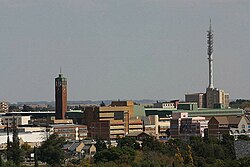Welkom
|
Welkom Matjhabeng |
|
|---|---|

Welkom's city center skyline
|
|
| Nickname(s): Circle City | |
|
|
|
| Coordinates: 27°58′59″S 26°43′15″E / 27.98306°S 26.72083°ECoordinates: 27°58′59″S 26°43′15″E / 27.98306°S 26.72083°E | |
| Country | South Africa |
| Province | Free State |
| District | Lejweleputswa |
| Municipality | Matjhabeng |
| Established | 1947 |
| Area | |
| • Total | 212.7 km2 (82.1 sq mi) |
| Elevation | 1,435 m (4,708 ft) |
| Population (2011) | |
| • Total | 211,011 |
| • Density | 990/km2 (2,600/sq mi) |
| Racial makeup (2011) | |
| • Black African | 84.9% |
| • Coloured | 3.7% |
| • Indian/Asian | 0.4% |
| • White | 10.8% |
| • Other | 0.2% |
| First languages (2011) | |
| • Sotho | 58.3% |
| • Afrikaans | 14.6% |
| • Xhosa | 13.6% |
| • English | 5.0% |
| • Other | 8.5% |
| Postal code (street) | 9459 |
| PO box | 9460 |
| Area code | 057 |
| Website | www.matjhabenglocalmunicipality.co.za |
Welkom (Afrikaans pronunciation: [ˈvɛlkɔm]) is the second-largest city in the Free State province of South Africa, located about 140 kilometres (90 mi) northeast of Bloemfontein, the provincial capital. Welkom is also known as Circle City, City Within A Garden, Mvela and Matjhabeng. The city's Sesotho name, Matjhabeng means 'where nations meet', derived from the migrant labour system, where people of various countries such as Lesotho, Malawi and Mozambique etc. met to work in the mines of the gold fields.
A settlement was laid out on a farm named "Welkom" (which is Afrikaans and Dutch for "welcome") after gold was discovered in the region, and it was officially proclaimed a town in 1948. The town became a municipality in 1961. It now falls in the Matjhabeng Municipality, part of the Lejweleputswa District. Welkom was officially declared a city on 14 February 1968.
Much of the history of Welkom is centred around the discovery of gold in the northwestern Free State. It was proclaimed a town in 1948, nines years after a major gold discovery was made in Odendaalsrus, just north of Welkom.
The first prospecting in the area was done by the Englishmen Mr Donaldson and Mr Hinds on a portion of the farm Zoeten-Inval in 1896. The men discovered a small outcrop which seemed to be a conglomerate pebble reef, but they failed to raise interest among mining companies who at that stage did not believe that there was gold to be discovered south of the Vaal River. They returned to England to test the samples they had extracted, but died before reaching their destination when their ship sank in the Bay of Biscay.
...
Wikipedia



